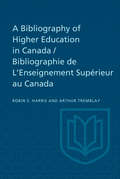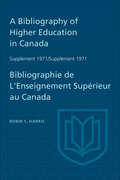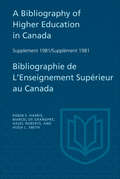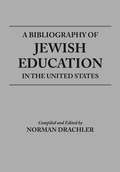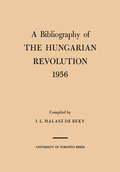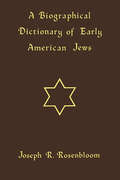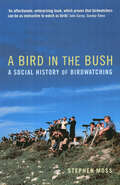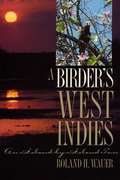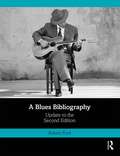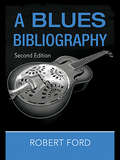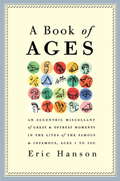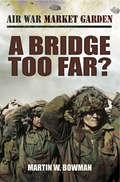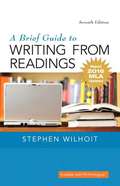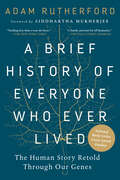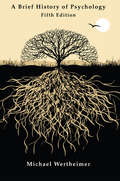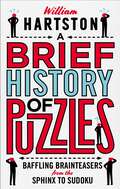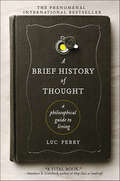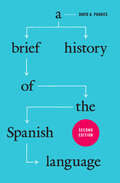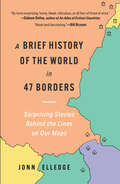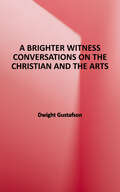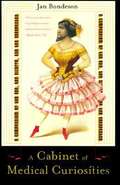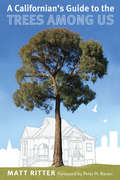- Table View
- List View
A Bibliography of Higher Education in Canada / Bibliographie de L'Enseignement Supérieur au Canada
by Robin Harris Arthur TremblayThis bibliography is the first of a series of studies about higher education in Canada sponsored by the committee on the History of Higher Education in Canada established by the National Conference of Canadian Universities. Among its nearly 4,000 entries are included the books, pamphlets, theses, dissertations, and articles in journals and magazines which supply the context and commentary on the history of Canadian higher education. Part I of the Bibliography provides the context; our universities do not exist in a vacuum—they are part of the economic, political, religious and social life of the community. Part I, therefore, includes a section on Canadian Culture, listing histories of Canada and its provinces, of its religious and social institutions, of its art, its economy, racial groups, relations with other countries. In order to study higher education in relation to other levels of education, another section lists works concerned with educational developments and problems at all levels. Part II lists the works bearing directly on higher education in Canada, and includes sections on History and Organization, Curriculum and Teaching, The Professor, The Student. Entries are arranged in chronological order in all sections in order to present the progressive development of each topic, and a full Index enables easy reference by author. No distinction has been drawn between English- and French-language publications: Chemistry and Chimie are one subject. The relative proportion of English and French entries in a section is often significant as indicating differences in the frequency and importance of particular fields of study in our colleges.
A Bibliography of Higher Education in Canada Supplement 1971 / Bibliographie de l'enseignement superieur au Canada Supplement 1971
by Robin HarrisThe 1971 Supplement adds some 3,500 entries to the approximately 7,000 listed in the original volume and the 1965 Supplement. Like its predecessors this volume provides a full list of the secondary sources related to Canadian higher education – books, articles, theses, dissertations, and reports published from 1964 to 1969. The reporting and arrangement of entries remains the same in the Supplement, but changes have been made in the overall organization of the material. New divisions have been created, more than a dozen sections have been subdivided, and a substantial number of new sections have been added. (Studies in Higher Education 5)
A Bibliography of Higher Education in Canada Supplement 1981 / Bibliographie de l'enseignement supérieur au Canada Supplément 198
by Hugh Smith Robin Harris Marcel De Grandpre Hazel RobertsThe 1981 Supplement adds more than 3000 entries to the approximately 10,500 listed in the original volume and in the 1965 and 1971 Supplements. Like its predecessors, this volume provides a full list of the secondary sources related to Canadian higher education – books, articles, theses ,dissertations, and reports published from 1971 to 1980. The reporting, arrangement of entries, and overall organization of the material remains the same as in the 1971 Supplement.
A Bibliography of Jewish Education in the United States
by Norman DrachlerThis book contains entries from thousands of publications whether in English, Hebrew, Yiddish, and German—books, research reports, educational and general periodicals, synagogue histories, conference proceedings, bibliographies, and encyclopedias—on all aspects of Jewish education from pre-school through secondary education
A Bibliography of William Wordsworth 1787-1930
by Mark L. ReedThe publishing history of William Wordsworth's writings is complex and often obscure. These two volumes set out, for the first time, a comprehensive, detailed bibliographic description of every edition of Wordsworth's writings up to 1930. The great variety of forms in which readers encountered both authorized and unauthorized texts by Wordsworth is revealed, not only as produced during his lifetime but also during the years of his largest sales, popularity and influence, the late nineteenth and early twentieth centuries. The bibliography provides new information about hundreds of printings and their internal and external designs, processes of production, sales, contents and variant texts and illustrations. More than a record of the transmission and reception of Wordsworth and his writings, it offers invaluable new data for the study of British publishing history and the reception and readership of British Romantic literature.
A Bibliography of the Hungarian Revolution, 1956
by Ivan Halasz de BekyThis bibliography is an exhaustive, objective and unique list of sources in the study of an event the historical significance of which becomes continually more apparent. The list consists of over two thousand entries from books and pamphlets, periodical articles, motion pictures and monitored broadcasts. The articles are arranged by language, and the Hungarian and Slavic book entries are provided with English translations.
A Biographical Dictionary of Early American Jews: Colonial Times Through 1800
by Joseph R. RosenbloomA remarkable reference for those interested in American Jewish history, comprising approximately four thousand names and supplemental data.Here is a near complete list of persons identifiable as Jews in America by 1800, the result of a thorough search of manuscript materials and published literature for the names of Jews who lived in America (including Canada up to 1783) during the seventeenth and eighteenth centuries.No other study provides comparable information for such an ethnic group in this country. The result of a years-long effort that began as a rabbinical thesis for the Hebrew Union College Jewish Institute of Religion and was eventually expanded, it serves as an essential reference for historians and other researchers.
A Bird in the Bush: A Social History of Birdwatching
by Stephen MossThis journey through the world of birdwatchers is “a wonderful book. . . . fascinating, often hilarious anecdotes and information” (Daily Mail, Critic’s Choice).Scholarly, authoritative, and above all supremely readable, Stephen Moss’s book is the first to trace the fascinating history of how and why people have watched birds for pleasure, from the beginnings with Gilbert White in the eighteenth century through World War II POWs watching birds from inside their prison camp and all the way to today’s “twitchers” with their bleeping pagers, driving hundreds of miles for a rare bird.“Proves that birdwatchers can be as instructive to watch as birds.” —Sunday Times“Thoroughly researched and well-written.” —The Guardian“Moss knows his subject intimately and writes about it with just the right mixture of affection and occasional quizzicality.” —Sunday Telegraph“It would be difficult to imagine anyone producing a more comprehensive, thoughtful, intelligent and entertaining examination of how people have watched birds at each point in history. In fact, it is one of the few books which might prove such compulsive reading that even a dedicated twitcher might forgo a day in the field to stay at home to finish it.” —Birding World
A Birder's West Indies: An Island-by-Island Tour
by Roland H. WauerThe West Indies offer so much more than sun, sand, and shopping. This sweeping arc of islands, which runs from Cuba to Grenada and includes the Virgin Islands, teems with a rich diversity of plant and animal life. Up to 40 percent of the plants in some forests are found nowhere else on earth, while the West Indian flyway is a critical link in the migratory routes of many birds. In A Birder's West Indies, Roland Wauer takes you on an island-by-island journey of discovery. He describes the unique natural features of each island and recounts his often fascinating experiences in seeking out the nearly 400 species of birds known in the West Indies. His accounts give insight into the birds' habitats, status, and ecology and record some of the threats posed by human activities. For readers planning trips to the West Indies, Wauer also includes helpful, up-to-date facts about the best times to travel, the kinds of entry and customs systems to expect, the money exchange services available, and general information about weather, food, and accommodations. Filling a unique niche among current guides, A Birder's West Indies offers both professional ornithologists and avocational bird watchers a chance to compare notes and experiences with an expert observer. And for readers who haven't yet visited the islands, Wauer's fluid prose and lovely color photographs will be the next-best thing to being there-and an irresistible invitation to go.
A Blues Bibliography: Second Edition: Volume 2
by Robert FordThis book provides a sequel to Robert Ford's comprehensive reference work A Blues Bibliography, the second edition of which was published in 2007. Bringing Ford's bibliography of resources up to date, this volume covers works published since 2005, complementing the first volume by extending coverage through twelve years of new publications. As in the previous volume, this work includes entries on the history and background of the blues, instruments, record labels, reference sources, regional variations, and lyric transcriptions and musical analysis. With extensive listings of print and online articles in scholarly and trade journals, books, and recordings, this bibliography offers the most thorough resource for all researchers studying the blues.
A Blues Bibliography: Second Edition: Volume 2
by Robert FordA Blues Bibliography, Second Edition is a revised and enlarged version of the definitive blues bibliography first published in 1999. Material previously omitted from the first edition has now been included, and the bibliography has been expanded to include works published since then. In addition to biographical references, this work includes entries on the history and background of the blues, instruments, record labels, reference sources, regional variations and lyric transcriptions and musical analysis. The Blues Bibliography is an invaluable guide to the enthusiastic market among libraries specializing in music and African-American culture and among individual blues scholars.
A Book of Ages
by Eric HansonAGE ISN’T JUST A NUMBER—IT’S A WAY OF KEEPING SCORE. THIS IS YOUR SCORECARD. The day we turn any age, we become contemporaries of everyone who has ever been that age, and it becomes our business to know that Bob Dylan wrote “Blowin’ in the Wind” when he was twenty, Orson Welles cowrote, directed, and starred in Citizen Kane when he was twenty-five, Winston Churchill was fired from the Admiralty when he was forty and took up painting, and Jane Austen died, unmarried and mostly unknown, when she was forty-one. Knowing who did what when provides the yardstick by which to measure our own progress; it’s comforting to learn that Grandma Moses didn’t show her first painting until she was seventy-eight, and discouraging (but not surprising) to discover that Einstein was already smarter than you at age sixteen. A witty, ironic collection of moments from famous lives organized by year of age from infancy to death,A Book of Agestells you who is doing what, who is on top of the world, who is waiting for his luck to change, who is saying unkind things about whom, who is planning his revenge, who is meeting for the first time, and who Elizabeth Taylor is currently divorcing. WHAT HAVE YOU BEEN UP TO? An Eccentric Miscellany of Achievements,Misdeeds, Crossed Paths, Bypaths, Inventions, Scandals, Child Prodigies, Late Masterpieces, Marriages and Breakups, Feuds, Dead Ends, Second Chances, Adventures and Misadventures, Novels Written and Battles Won and Lost, All Organized by Year of Age. From the Hardcover edition.
A Bridge Too Far?: Volume 4 (Air War Market Garden #4)
by Martin W. BowmanThis, the fourth and final volume of the series on Market-Garden in September 1944 reveals the final fate of the troops at Oosterbeek and the decision to evacuate all able bodied men in Operation 'Berlin' as well as the subsequent Operation 'Pegasus' when the Allies tried to return as many beleaguered troops back to Allied lines as possible. Was Arnhem indeed 'a bridge Too Far'? While 'Market-Garden' certainly was a heroic failure conducted at great cost it is debatable whether it contributed materially to the ultimate victory or was a foolish sacrifice of thousands of troops, aircrew and Dutch civilians in an ill-conceived assault on the German-held bridges across the Lower Rhine. There is no doubting the gritty, gallant and valorous contribution on the part of the British, Dominion, American and Polish paratroopers, the RAF and USAAF aircrews and their German opponents and Dutch civilians. Their incredible, illuminating and often under-stated accounts of extraordinary courage, camaraderie, shared terror and encounters with the enemy offer a more personalised view of 'Market-Garden' through the words of those who were there at the heart of the action. These tales are complemented by the author's background information supplemented by the inclusion of daily timelines that give an overall picture of each battle and air operation.
A Brief Guide To Writing From Readings
by Stephen WilhoitA Brief Guide to Writing from Readings is a clear, process-oriented guide to academic writing. The guide covers the subtleties of rhetorical analysis and argumentation strategies as well as the technical aspects of writing with sources. Students will learn first to examine texts critically and then to clearly, accurately and creatively respond in essay form. In-text tools including summary charts and revision checklists help students tackle source-based essays step by step. Instructors will rely on the guide as a one-stop reference tool; students can apply their learning to any discipline, whether for class work or independent study. <p><p> In the Seventh Edition, in response to student and faculty feedback, Wilhoit includes a new chapter on analyzing readings and composing analytical essays; more coverage of literary analysis and a new short story; eight academic readings; and expanded coverage of how to cite electronic sources in APA and MLA style.
A Brief History of Everyone Who Ever Lived: The Human Story Retold Through Our Genes
by Siddhartha Mukherjee Adam RutherfordNational Book Critics Circle Award—2017 Nonfiction Finalist “Nothing less than a tour de force—a heady amalgam of science, history, a little bit of anthropology and plenty of nuanced, captivating storytelling.”—The New York Times Book Review, Editor’s Choice A National Geographic Best Book of 2017 In our unique genomes, every one of us carries the story of our species—births, deaths, disease, war, famine, migration, and a lot of sex. But those stories have always been locked away—until now. Who are our ancestors? Where did they come from? Geneticists have suddenly become historians, and the hard evidence in our DNA has blown the lid off what we thought we knew. Acclaimed science writer Adam Rutherford explains exactly how genomics is completely rewriting the human story—from 100,000 years ago to the present.
A Brief History of Psychology
by Michael WertheimerThis brief, inexpensive text offers the utmost in flexibility in teaching the history of psychology. Used as a stand-alone text or with readers, this engaging book is noted for its analysis of the scientific and philosophical emergence of the field. Readers appreciate the book’s balanced coverage of experimental, applied, and clinical psychology, as well as the clear and succinct presentation of the field’s major events and schools of thought. This edition features an expanded pedagogical program with bolded terms, a complete glossary, more illustrations, and web-based instructional materials including Power Points, a test bank, discussion questions, and more. Extensively updated throughout, this edition features: A new final chapter with a current analysis of the state of the field including the growth of specialized organizations that promote the science of psychology and the push to influence policies that address global challenges such as environmental sustainability, intergroup conflict, health disparities, and the population explosion. A discussion of the growth in the number and role of women in psychology and the promotion of diversity initiatives related to ethnicity, gender, age, and sexual orientation. Recent developments in the growth of neuroscience, cognitive science, and the diversification of psychology. Portraits of some major figures in the history of psychology. Recent changes in the practice of psychology including more emphasis on "evidence-based practice," prescription privileges, and the application of psychological principles to industrial and engineering psychology. Recent changes in the APA including new divisions and new elected officials. Used independently or as a supplement with readers, this brief text is intended for undergraduate and graduate courses on the history of psychology. Due to its brevity and engaging style, the book is often used in introductory courses to introduce students to the field. The enormous index and substantial glossary make this volume a useful desk reference for the entire field.
A Brief History of Puzzles: Baffling Brainteasers from the Sphinx to Sudoku
by William HartstonFrom ancient riddles to modern Sudoko, people have been fascinated by puzzles. Whether they are seen as a glorious waste of time, a harmless way to spend a train journey or a valuable way of exercising the mind, the lure of puzzles has been irresistible. By using over 100 examples of the most mindbending, the most challenging, the most satisfying, or simply the most humorous puzzles throughout the ages, William Hartston traces the development of brainteasers of all varieties and the increasing ingenuity of puzzle setters from ancient civilizations to modern puzzle crazes.
A Brief History of Thought: A Philosophical Guide to Living (Learning to Live)
by Luc Ferry“Succinct and accessible” this international bestselling survey is “perfect for anyone who wants to dip their toe into the waters of philosophy” (Matt Haig, Washington Post).From the timeless wisdom of the ancient Greeks to Christianity, the Enlightenment, existentialism, and postmodernism, Luc Ferry’s instant classic brilliantly and accessibly explains the enduring teachings of philosophy—including its profound relevance to modern daily life and its essential role in achieving happiness and living a meaningful life. This lively journey through the great thinkers will enlighten every reader, young and old.“This superb primer is proof that philosophy belongs at the center of life.” —Publishers Weekly, starred review“Ferry's openness, energy, and charm as a teacher burst through on every page. However difficult the questions he poses, his eagerness to find answers, to justify philosophy as a way of life, is infectious.” —Wall Street Journal“For everyone from the man in the street to the man in the Acropolis—a fine introduction to philosophy and its fundamental relevance to living a meaningful life.” —Thomas Cathcart and Daniel Klein, New York Times–bestselling authors of Plato and a Platypus Walk into a Bar“This is a vital book. Luc Ferry rehabilitates the ancient question, ‘What is the best way of life?’ as though our lives depended on it.” —Matthew B. Crawford, New York Times–bestselling author of Shop Class as Soulcraft“No dry academic, Ferry restores to philosophy a compelling urgency.” —Booklist, starred review
A Brief History of the Spanish Language
by David A. PhariesSince its publication in 2007, A Brief History of the Spanish Language has become the leading introduction to the history of one of the world's most widely spoken languages. Moving from the language's Latin roots to its present-day forms, this concise book offers readers insights into the origin and evolution of Spanish, the historical and cultural changes that shaped it, and its spread around the world. A Brief History of the Spanish Language focuses on the most important aspects of the development of the Spanish language, eschewing technical jargon in favor of straightforward explanations. Along the way, it answers many of the common questions that puzzle native speakers and non-native speakers alike, such as: Why do some regions use tú while others use vos? How did the th sound develop in Castilian? And why is it la mesa but el agua? David A. Pharies, a world-renowned expert on the history and development of Spanish, has updated this edition with new research on all aspects of the evolution of Spanish and current demographic information. This book is perfect for anyone with a basic understanding of Spanish and a desire to further explore its roots. It also provides an ideal foundation for further study in any area of historical Spanish linguistics and early Spanish literature. A Brief History of the Spanish Language is a grand journey of discovery, revealing in a beautifully compact format the fascinating story of the language in both Spain and Spanish America.
A Brief History of the World in 47 Borders: Surprising Stories Behind the Lines on Our Maps
by Jonn Elledge#1 International Bestseller Every border tells a surprising story in this uncommonly enlightening history that will change the way you understand the world “A novel and fascinating perspective on world history.”—Bill Bryson, author of A Short History of Nearly Everything Many lines on the map are worth far more than a thousand words, going well beyond merely marking divisions between nations. In this eye-opening investigation into the most remarkable points on the map, a single boundary might, upon closer inspection, reveal eons of history—from epic tales of conquest, treaties, and alliances to intimate, all-too-human stories of love, greed, and folly. Sometimes rooted in physical geography, sometimes entirely arbitrary, none of the lines we know today were inevitable, and all might have looked quite different if not for the intricate interplay of chance and ambition. By listening to the stories these borders have to tell, we can learn how political identities are shaped, why the world’s boundaries look the way they do—and what they tell us about our world and ourselves. From the very first maps in Egypt to the Roman attempts to define the boundaries of civilization, from the profound shift in meaning of the Mason–Dixon line to the secret British-French agreement to carve up the Ottoman Empire during the First World War, and from the dark consequences of Detroit’s city limits to the intriguing reason why landlocked Bolivia still maintains a navy, this is a singular look at human history—told through its most spellbinding border stories.
A Brighter Witness: Conversations on the Christian and the Arts
by Dwight Gustafson"Essays on the Christian and the Arts"--Provided by publisher.
A CRITICAL EXAMINATION OF THE POSITION OF MR. DARWIN'S WORK, "ON THE ORIGIN OF SPECIES,"
by Thomas Henry HuxleyA Critical Examination of the Position of Mr. Darwin's Work, "On the Origin of Species," in Relation to the Complete Theory of the Causes of the Phenomena of Organic Nature Lecture VI. (of VI.), "Lectures to Working Men", at the Museum of Practical Geology, 1863, on Darwin's Work: "Origin of Species"
A Cabinet of Medical Curiosities
by Jan BondesonIn this book of amazing oddities, Jan Bondeson explores unexpected, gruesome, and bizarre aspects of the history of medicine. He regales us with stories of spontaneous human combustion; vicious tribes of tailed men; the Two-Headed Boy of Bengal; Mary Toft, who allegedly gave birth to seventeen rabbits; and Julia Pastrana, exhibited around the world as the Ape Woman. Bondeson combines an historian's skill in showing us our timeless fascination with the grotesque with a physician's diagnostic abilities, as he examines the evidence and provides likely explanations for these peculiar events. "Fascinating. . . . Well-researched and extensively illustrated with items from [Bondeson's] personal collection, it covers a wide range of medical monstrosities, and there is something for everyone. " â " The Lancet "Entertaining in the simultaneously creepy and amusing way of a carnival sideshow. . . . Bondeson is quick to acknowledge absurdity, and his wry humor, along with his strong personal judgments, spice up the book. " â " Publishers Weekly "Bondeson . . . regards his exhibits with a careful scientist's eye, discovering misinterpreted evidence, tragic genetic mutations, and, occasionally, outright fraud. " â " Library Journal
A Calgary Album: Glimpses of the Way We Were
by Mark Kozub Janice KozubBefore becoming the oil capital of the nation, Calgary was a nineteenth-century boomtown in the heart of Alberta. The roots of great prosperity were growing, despite the fact that politicians and the general public believed the West was best left to the trapper and trader. Nurtured by a sense of vision and the sweat of good old-fashioned hard work, Calgary grew, and has now blossomed into a world-class cosmopolitan city noted for its burgeoning oil and gas industry, its famed Calgary Zoo, and of course, the Stampede. A Calgary Album is a sentimental journey into a cattle town that grew to be so much more. Through sixty-five glorious black and white photographs and engaging storytelling, the authors take the reader back to the time of the "real" cowboys, to the days when the streetcar seemed like science fiction, through the Depression, the great wars, the times of boom, bust, and recovery. We revisit the movers, the shakers, and the honourable everyday people who turned this "cow town" into a city worth bragging about.
A Californian's Guide to the Trees among Us
by RitterWe bring the strength and beauty of the natural world into our urban landscapes by planting trees, and California is blessed with a rich horticultural history, visible in an abundance of cultivated trees that enrich our lives with extraordinary color, bizarre shapes, unusual textures, and unexpected aromas. A Californian’s Guide to the Trees among Us features over 150 of California’s most commonly grown trees. Whether native or cultivated, these are the trees that muffle noise, create wildlife habitats, mitigate pollution, conserve energy, and make urban living healthier and more peaceful. Used as a field guide or read with pleasure for the liveliness of the prose, this book will allow readers to learn the stories behind the trees that shade our parks, grace our yards, and line our streets. Rich in photographs and illustrations, overflowing with anecdote and information, A Californian’s Guide to the Trees among Us opens our eyes to a world of beauty just outside our front doors.
